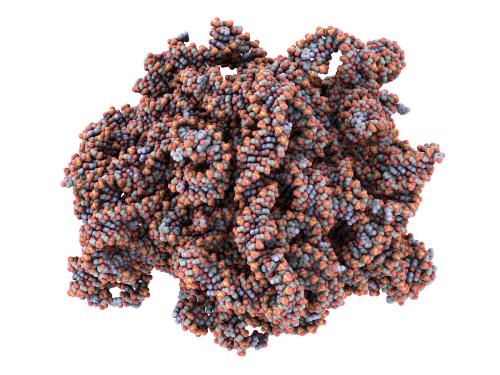Let us now consider the pathway used to form the ribosome subunits. More than 80 ribosomal proteins are synthesized in the cytoplasm and then imported into the nucleolus. Investigators initially thought that the eukaryotic ribosomes might self-assemble with the assistance of new, if any, nonribosomal proteins. The reason for this expectation was that in Vitro studies showed bacterial ribosomal subunits could assemble spontaneously, without any demonstrable need for cofactors or folding chaperones. However, it soon became evident that eukaryotic ribosome assembly is a complex process that does require assistance from nonribosomal proteins. Although much of our current knowledge of eukaryotic ribosomal assembly comes from studies in yeast, ribosomal assembly in other eukaryotes appears to proceed in a similar fashion.
Pioneering studies performed independently by the laboratories of Jonathan Warner and Rudi J. planta in the 1970s identified the earliest pre-ribosomal assembly, the 90S particle, so-named because of its sedimentation in a sucrose gradient. This particle, which contains the 35S pre-rRNA as well as many ribosomal proteins, has a relatively high ratio of protein to RNA compared to mature ribosomes. The high protein composition suggested that the 90S particle have additional nonribosomal proteins that are lost when the 90S particle move from the nucleolus to the cytoplasm. These early studies also showed that the 90S particles,the precursors to the mature 60S and 40S subunits,respectively. The technology available in the 1970s and for the next two decades was unable to provide much information about the composition of 90S particles and the nonribosomal proteins associated with them. The chief difficulty was in isolating the intact 90S particle and other pre-ribosome assemblies free from contaminants.
A new technique known as tandem affinity purification(TAP),which was devised by Bertrand Seraphin and coworkers in 1999,has permitted investigators to isolate and characterize many pre-ribosome assemblies and thereby provide a more complete picture of the ribosome assembly process. The tandem affinity purification procedure,has the great advantage of allowing ribonucleoprotein or protein complexes to be isolated in highly pure form under very mild conditions so that the complexes retain their native structure.
The first task is to use recombinant DNA technology to modify one of the proteins (the so-called bait protein)in the ribonucleoprotein or protein complex under study so that the bait protein has a TAP tag attached to its N-or C-terminus. The TAP tag consists of three parts, a calmodulin-binding peptide, a tobacco etch virus (TEV)protease cleavage site, and an immunoglobulin G (lgG)binding domain from protein A. Cells or organisms are constructed that contain TAP-tagged bait protein(s).Then cell-free extracts are prepared under mild conditions and tandem affinity purification is performed. 







